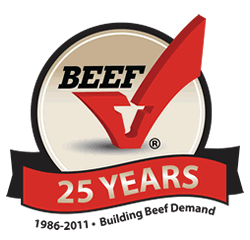Your National Beef Checkoff Program: 25 Years And Counting
PART 1: Turning your $1-per-head assessments into opportunities.
It was 1986: A gallon of gas cost 89¢; a pound of ground beef cost about $1.29 at retail; a movie ticket was $3.71; the average price of the average monthly rent was $385; the average price of a home was $89,430; and the national Beef Checkoff Program went into effect at $1 per head.

Fast forward to 2011: Today, a gallon of gas will set you back an average of $3.26; the average price for a pound of ground beef is $3.87; a movie ticket costs about $8.50; the average monthly rent is $812; the average price of a home is $303,713; and, still $1 per head, the national beef checkoff is wrapping up its first 25 years of serving as a catalyst to spur beef sales worldwide.
Today, beef is the No. 1 selling protein in restaurants in particular and in the United States in general, with consumer spending on beef totaling $73.4 million in 2010. More than 85% of consumers know the industry's Beef. It's What's for Dinner slogan, currently serving as the base of the Beef Checkoff Program.
With this article the Beef Board embarks on a six-part series featuring 25 years of beef checkoff successes. Walking through the 25-year history of the beef industry will take you down some rocky roads, as well as highlight some clear paths to growth, all en route to a beef industry that you'll be proud to pass on to the next generation.
Beef demand
Let's start by talking about beef demand. While building demand for beef clearly is one of the goals of the checkoff, that goal often is misunderstood. That's because beef demand is commonly confused with beef consumption, though the two are very different. In fact, beef consumption actually can drop in concert with beef demand increasing, if consumers are willing to pay more for their favorite protein.
In reality, per capita consumption is best seen as a "disappearance" number. As agricultural economist Wayne Purcell explains: "Add beginning inventories and production to imports, then subtract ending inventories, exports and disappearance, and divide by population." As a disappearance number, we "consumed" an estimated 59.7 pounds (lb.) of beef per capita in the United States in 2010, for example, because that is how much beef we had in the United States. But that number has a lot to do with supply and availability — and little, if anything, to do with demand.
Instead, beef demand is the set of quantities of beef that consumers will purchase at different prices. If, for example, we have a quantity of 59.7 lb. of beef per capita to sell, it is price that will adjust to clear the market — and the price that consumers are willing to pay will depend on how much consumers like the product offerings, as well as the price of other meats and consumer income levels.
A correlation might help: Say, for example, a vehicle manufacturer builds too many pickups and, as the model year nears its end, it offers huge discounts to get them off the lots. All of the current-year pickups will be sold, or consumed, but we certainly would not say the demand for that manufacturer's pickups is robust when the prices have to be cut in half to get them sold. Similarly, if you are a purebred breeder and seller of bulls, is there not a problem with demand if the only way you can sell as many bulls as last year is at a 20% decline in price?
If we use consumption as a measure of demand, we ignore the desirability of what we offer and we go, as we did for nearly 20 years, Purcell says, with an unacceptable product offering, where up to 25% of the steaks and roasts from Choice beef were too tough to chew.
Demand will only be forthcoming, Purcell says, as we understand demand and offer consumers what they want in the form of a continuing series of new quality-controlled products. There simply has to be a consumer-level willingness to pay that supports and finances all this progressive change over time.
That's where your Beef Checkoff Program comes in.
What has my beef checkoff done for me lately
With that understanding of beef demand under your belt, you'll quickly realize that your checkoff cannot single-handedly change a bad market. Instead, it is meant to act as a catalyst for other industry players to help sell beef.
With that said, producers and importers often ask what they get for their checkoff dollar, and that is one of the reasons that the checkoff reports results of individual programs on a regular basis to keep all checkoff investors informed. But with 25 years of success stories to tell, we'd like to go through some highlights in each program area — promotion, research, consumer information, industry information, and foreign marketing — more in depth.
So, this series will take you through the success stories of your Beef Checkoff Program in its current form, beginning with promotion programs, including Beef. It's What's For Dinner. and its predecessors, starting with Promotion in Part 2.
Click here for Part 2
Click here for Part 3
Click here for Part 4
Click here for Part 5
Click here for Part 6













